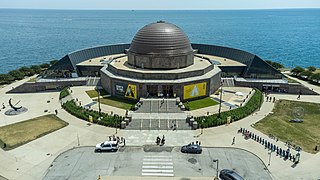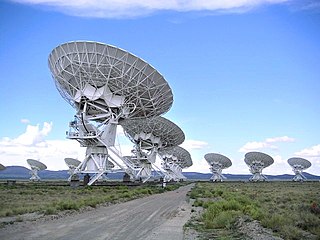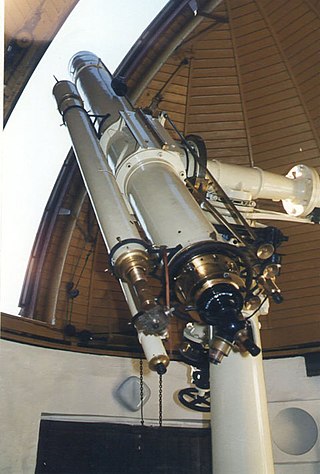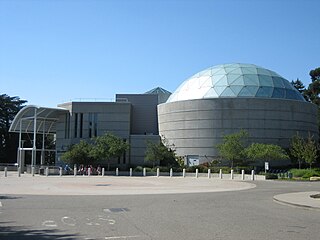
A space telescope or space observatory is a telescope in outer space used to observe astronomical objects. Suggested by Lyman Spitzer in 1946, the first operational telescopes were the American Orbiting Astronomical Observatory, OAO-2 launched in 1968, and the Soviet Orion 1 ultraviolet telescope aboard space station Salyut 1 in 1971. Space telescopes avoid the filtering and distortion (scintillation) of electromagnetic radiation which they observe, and avoid light pollution which ground-based observatories encounter. They are divided into two types: Satellites which map the entire sky, and satellites which focus on selected astronomical objects or parts of the sky and beyond. Space telescopes are distinct from Earth imaging satellites, which point toward Earth for satellite imaging, applied for weather analysis, espionage, and other types of information gathering.

The Adler Planetarium is a public museum in Chicago, Illinois, dedicated to astronomy and astrophysics. It was founded in 1930 by local businessman Max Adler. Located on the northeastern tip of Northerly Island on Lake Michigan, the Adler Planetarium was the first planetarium in the United States. It is part of Chicago's Museum Campus, which includes the John G. Shedd Aquarium and The Field Museum. The Planetarium's mission is to inspire exploration and understanding of the universe.

The Karl G. Jansky Very Large Array (VLA) is a centimeter-wavelength radio astronomy observatory in the southwestern United States. It lies in central New Mexico on the Plains of San Agustin, between the towns of Magdalena and Datil, approximately 50 miles (80 km) west of Socorro. The VLA comprises twenty-eight 25-meter radio telescopes deployed in a Y-shaped array and all the equipment, instrumentation, and computing power to function as an interferometer. Each of the massive telescopes is mounted on double parallel railroad tracks, so the radius and density of the array can be transformed to adjust the balance between its angular resolution and its surface brightness sensitivity. Astronomers using the VLA have made key observations of black holes and protoplanetary disks around young stars, discovered magnetic filaments and traced complex gas motions at the Milky Way's center, probed the Universe's cosmological parameters, and provided new knowledge about the physical mechanisms that produce radio emission.

A refracting telescope is a type of optical telescope that uses a lens as its objective to form an image. The refracting telescope design was originally used in spyglasses and astronomical telescopes but is also used for long-focus camera lenses. Although large refracting telescopes were very popular in the second half of the 19th century, for most research purposes, the refracting telescope has been superseded by the reflecting telescope, which allows larger apertures. A refractor's magnification is calculated by dividing the focal length of the objective lens by that of the eyepiece.

Parkes Observatory is a radio astronomy observatory, located 20 kilometres (12 mi) north of the town of Parkes, New South Wales, Australia. It hosts Murriyang, the 64 m CSIRO Parkes Radio Telescope also known as "The Dish", along with two smaller radio telescopes. The 64 m dish was one of several radio antennae used to receive live television images of the Apollo 11 Moon landing. Its scientific contributions over the decades led the ABC to describe it as "the most successful scientific instrument ever built in Australia" after 50 years of operation.

The Stratospheric Observatory For Infrared Astronomy (SOFIA) was an 80/20 joint project of NASA and the German Aerospace Center (DLR) to construct and maintain an airborne observatory. NASA awarded the contract for the development of the aircraft, operation of the observatory and management of the American part of the project to the Universities Space Research Association (USRA) in 1996. The DSI managed the German parts of the project which were primarily science- and telescope-related. SOFIA's telescope saw first light on May 26, 2010. SOFIA was the successor to the Kuiper Airborne Observatory. During 10-hour, overnight flights, it observed celestial magnetic fields, star-forming regions, comets, nebulae, and the Galactic Center.

The Kopernik Observatory & Science Center (KOSC), is a public observatory in Vestal, New York opened to the public on 16 June 1974 by the Kopernik Society of Broome County to commemorate the 500th anniversary of the birth of the astronomer Nicolaus Copernicus in 1973. Its mission is to offer hands-on investigations and outreach programs for educating all ages about astronomy and science using advanced optical telescopes, computers and other tools. It is the first science laboratory facility in New York State designed for K-12 teachers, students and their families, and has been one of the best-sited and best equipped public observatories in the Northeast United States for nearly the last 40 years.

The Center for Astrophysics | Harvard & Smithsonian (CfA), previously known as the Harvard–Smithsonian Center for Astrophysics, is an astrophysics research institute jointly operated by the Harvard College Observatory and Smithsonian Astrophysical Observatory. Founded in 1973 and headquartered in Cambridge, Massachusetts, United States, the CfA leads a broad program of research in astronomy, astrophysics, Earth and space sciences, as well as science education. The CfA either leads or participates in the development and operations of more than fifteen ground- and space-based astronomical research observatories across the electromagnetic spectrum, including the forthcoming Giant Magellan Telescope (GMT) and the Chandra X-ray Observatory, one of NASA's Great Observatories.

Astronomy Day is an annual event in various countries, intended to provide a means of interaction between the general public and various astronomy enthusiasts, groups and professionals.

The Maria Mitchell Observatory in Nantucket, Massachusetts, USA, was founded in 1908 and named in honor of Maria Mitchell, the first American woman astronomer. It is a major component of the Maria Mitchell Association. The Observatory actually consists of two observatories - the main Maria Mitchell Observatory near downtown Nantucket and the Loines Observatory about a kilometer west of town. It is also the repository for a valuable collection of over 8000 wide-field glass photographic plates, recording observations of large swaths of sky from 1913 to 1995.

Pine Mountain Observatory (PMO) is an astronomical observatory owned and operated by University of Oregon Department of Physics. The facility is located 26 miles (42 km) southeast of Bend, Oregon (USA) in the Deschutes National Forest near the summit of Pine Mountain.

The Dyer Observatory, also known as the Arthur J. Dyer Observatory, is an astronomical observatory owned and operated by Vanderbilt University. Built in 1953, it is located in Nashville, Tennessee, and is the only university facility not located on the main campus in Nashville. The observatory is named after Arthur J. Dyer, who paid for the observatory's 24-foot (7.3 m)-wide dome, and houses a 24-inch (610 mm) reflecting telescope named for astronomer Carl Seyfert. Today, the observatory primarily serves as a teaching tool; its mission is to interest the public in the fields of astronomy, science and engineering. The observatory was listed on the National Register of Historic Places on March 6, 2009.

Fremont Peak Observatory (FPOA) is an astronomical observatory operated by Fremont Peak Observatory Association (FPOA) under contract to the State of California. Built in 1986, it is located in Fremont Peak State Park, near San Juan Bautista, California. Fremont Peak Observatory houses the Challenger telescope.

The International Year of Astronomy (IYA2009) was a year-long celebration of astronomy that took place in 2009 to coincide with the 400th anniversary of the first recorded astronomical observations with a telescope by Galileo Galilei and the publication of Johannes Kepler's Astronomia nova in the 17th century. The Year was declared by the 62nd General Assembly of the United Nations. A global scheme, laid out by the International Astronomical Union (IAU), was also endorsed by UNESCO, the UN body responsible for educational, scientific, and cultural matters.

Chabot Space and Science Center, located in Oakland, California, is a center for science learning featuring interactive exhibits, planetariums, a large screen theater, hands-on activities and three powerful telescopes.

The University of Illinois Astronomical Observatory, located at 901 S. Mathews Avenue in Urbana, Illinois, on the campus of the University of Illinois Urbana–Champaign, was built in 1896, and was designed by Charles A. Gunn. It was listed on the National Register of Historic Places on November 6, 1986, and on December 20, 1989, was designated a National Historic Landmark.

The Heights Observatory is an Astronomical Observatory at The Heights School in Modbury Heights, Adelaide, South Australia.

Arthur C. Clarke Institute for Modern Technologies (ACCIMT) is an institute for research and technology transfer in Sri Lanka. It is named after its founder patron, Sir Arthur C. Clarke, the famous British science fiction author, inventor and futurist. The institute is mainly focused on conducting research in the fields of electronics, micro-electronics, telecommunications, information technology, space technologies and robotics, and providing training for relevant industry professionals. It is one of the few institutions of this kind in Sri Lanka.

On September 14, 2015, then 14-year-old Ahmed Mohamed was arrested at MacArthur High School in Irving, Texas, for bringing a disassembled digital clock to school. The incident ignited allegations of racial profiling and Islamophobia from many media sources and commentators.






















